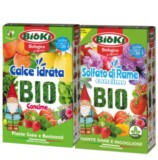Poltiglia Bordolese

Come preparare la poltiglia Bordolese
BORDEAUX POLISH is a mixture of COPPER SULPHATE (with an acidic pH) and lime (an alkaline and therefore neutralizing substance) which react to give rise to several compounds that vary depending on the method of preparation. HYDRATED LIME is a completely natural product that is obtained from the cooking of limestone rocks just as COPPER is obtained from mines. Products containing slurry are typically registered as Not Classified (Nc). The reclassification of plant protection products according to community directive 99/45/EC implemented with Legislative Decree no. 65 of 14 March 2003, today places many cupric preparations and many ready-made mixtures in class ". The maximum quantity of copper metal allowed is 6 kg/ha/year. Only for VINE, PEAR and APPLE TREE it is possible to calculate this quantity on a five-year average: for the period 2002-2006 a total of 38 kg of copper per hectare must not be exceeded (in the period 2003-2007 it will be 36 kg of copper per hectare). By varying the doses of copper and lime it is possible to obtain acidic, alkaline or neutral mixtures.
The doses of Bordeaux mixture can never be standardized as they certainly depend on the seasonal period in which one finds oneself, on the meteorological trend and the vegetative growth of the crop, on the area and on the aggressiveness of the diseases to be fought. During the winter, when the fruit trees are in the resting stage, the mash can be used at a rather high dose, even 1.5 - 2.0 kg per quintal of water, as the wood has good resistance. However, here too variety and species represent a discriminating factor: for example on peach the doses must be lower than on pome fruit. It is best that the temperature does not fall below freezing during distribution and in the following days. If we deal with the problem of downy mildew on the vine, we need to use at least 100 g of copper ion per hl of water
Solfato di rame e calce idrata

€22,35 €29,80
Bioki Offer composed of 500 g Copper Sulphate + 500 g Hydrated Lime, High solubility. Suitable for vegetable, fruit and garden plants.